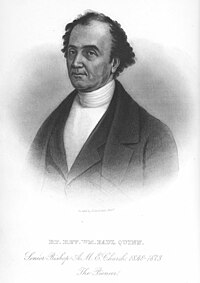William Paul Quinn

William Paul Quinn (10 April 1788–21 February 1873)
In 1836 Quinn was assigned as a missionary to what was known as the Northwest, specifically Indiana and Ohio, although he also traveled to Illinois and Missouri. He settled in Richmond, Indiana as his base, founding an AME Church there and several throughout these states. In 1844 he was elected as bishop and in 1849 as Senior Bishop of the church.
Early life and education
By his own account, Quinn was said to have been born in
Religious career
Quinn came to the US by 1808, when he became involved in the AME Church in New Jersey. He was among the founders of the denomination in 1816, the first black independent denomination in the United States. According to that account, he was ordained a deacon in 1818. His wife was Mary Jane Quinn.
In 1836 Quinn was assigned as a missionary to the
Quinn settled with his wife in Richmond, Indiana, which he used as a base for his missionary work. Quinn became an elder in 1838. They founded the Bethel A.M.E. Church in Richmond, as well as similar churches in Dublin, Newport(now Fountain City), and Cambridge City, Indiana, and most of the AME churches in Ohio and Indiana.
On May 19, 1844, due to his success in planting churches in the Northwest, the General Conference of the church elected him a bishop. He became the Senior Bishop of the church in May 1849, serving until his death in Richmond on February 3, 1873. During that period, another 47 AME congregations were established from
Quinn was known for saying that the
Quinn was buried at Earlham Cemetery in Richmond.
Legacy and honors
- freedmen and later moved to Waco, Texas. In 1991 Paul Quinn College moved to Dallas, Texas, where it remains today.
Notes
- ^ "In Memoriam: Funeral Services in Respect to the Memory of Rev. William Paul Quinn, Late Senior Bishop of the African M.E. Church, Held at Warren Chapel, Toledo, Ohio, March 9th, 1873"
- ^ a b Candace Staten, "William Paul Quinn", Black Past, accessed 15 January 2015
- ^ Véronique LaCapra, "Archaeologists Dig For Clues To African-American History In Brooklyn, Ill.", St. Louis Public Radio, 13 October 2014, accessed 15 January 2015
References
- Nathan Aaseng, "Quinn, William Paul," African-American Religious Leaders, Revised Edition, A to Z of African Americans (New York: Facts On File, Inc., 2011)
- Benjamin W. Arnett, In Memoriam: Funeral Services in Respect to the Memory of Rev. William Paul Quinn, Late Senior Bishop of the African M.E. Church, Held at Warren Chapel, Toledo, Ohio, March 9th, 1873 (Toledo: Published by Warren Chapel, 1873)
- Tarunjit S. Butalia, and Dianne P. Small, Religion in Ohio: Profiles of Faith Communities (Athens, OH: Ohio University Press, 2004)
- Tom Calarco and Cynthia Vogel, Places of the Underground Railroad: A Geographical Guide (Santa Barbara, CA: Greenwood, 2011)
- Dennis C. Dickerson, "African Methodist Episcopal Church," Encyclopedia of African-American Culture and History, Colin A. Palmer, ed., Vol. 1 (Detroit: Macmillan Reference, 2006)
External links
- Candace Staten, "William Paul Quinn", Black Past
- William Paul Quinn at Find a Grave
